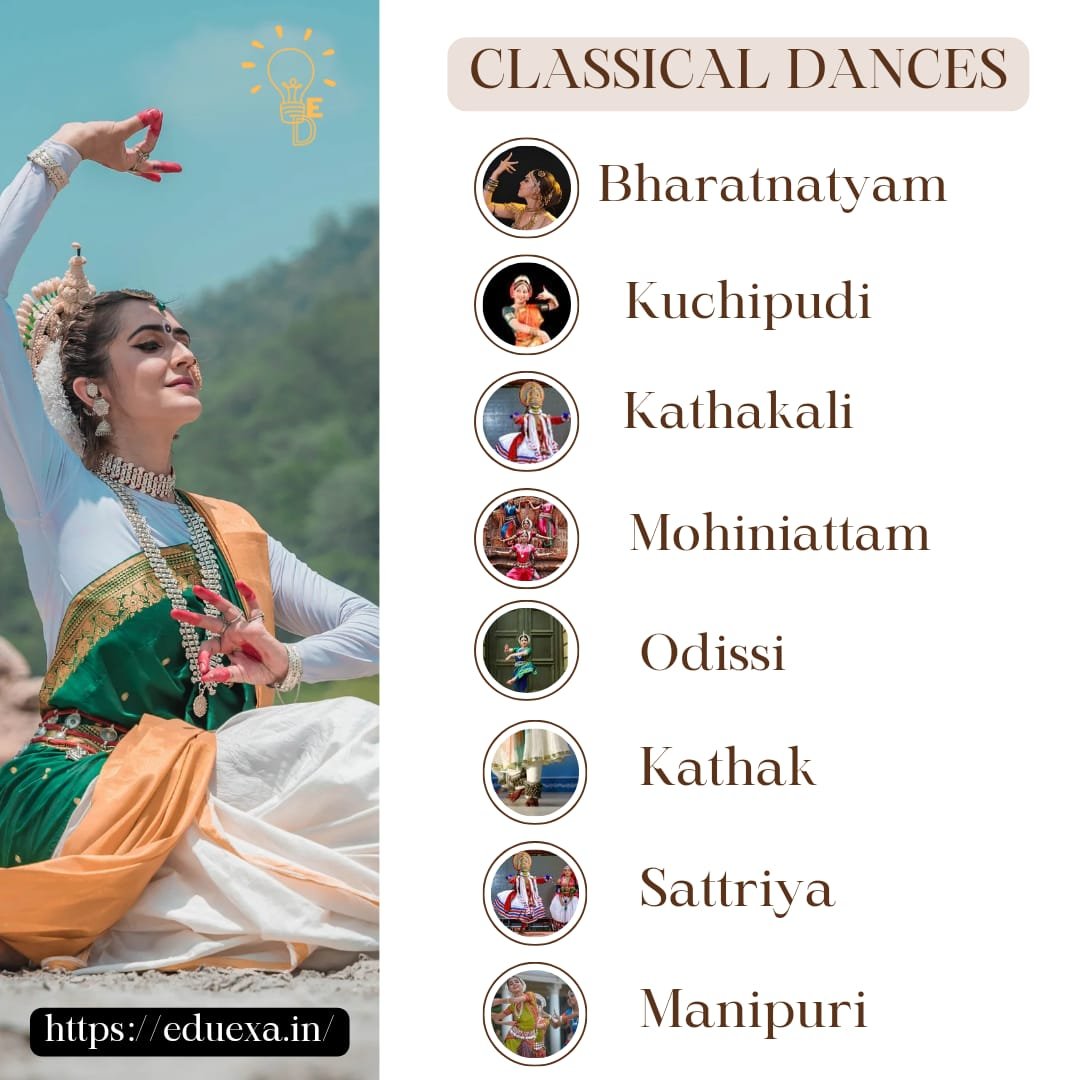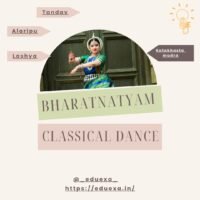India, known for its cultural diversity and deep-rooted traditions, boasts a plethora of classical dance forms, each with its own unique style, repertoire, and history. These dances not only reflect the country’s cultural heritage but also serve as a medium to convey stories from mythology, spirituality, and everyday life.
Read about the Folk Dances of India here.
Recognition and classification
The status of a dance as classical dance is determined or accorded by Sangeet Natak Akademi. Presently 8 dances are categorised as classical dances by Sangeet Natak Akademi. The ministry of culture recognises 9 classical dances including the Chhau dance.
Features of classical dances
Each of the classical dances are known for their unique dress, expressions, mudras and other distinctive features:
- Technique and Form: They have highly developed techniques with specific rules for body movement, footwork, hand gestures (mudras), and facial expressions (abhinaya).
Ex- Katakhastha Mudra (symbolises om)
- Costumes and Makeup: Performers wear traditional costumes that are often elaborate, along with specific makeup styles that enhance facial expressions and visibility under stage lights.
Ex- Different colours denoting different emotions in Kathakali.
- Music and Rhythm: They are accompanied by classical music that follows complex rhythmic patterns (taal) and melodic structures (ragas), often performed live with instruments like tabla, mridangam, sitar, or flute.
Ex- Use of carnatic music is a common feature in south indian dances.
- Narrative and Themes: Classical dances often depict stories from mythology, folklore, or spiritual themes. Each movement and gesture (mudra) contributes to storytelling (abhinaya).
Ex- Stories Shiv and Parvati associated with the Manipuri Dance
- Training and Guru-Shishya Tradition: Dancers undergo rigorous training typically under a guru (teacher) in a tradition known as Guru-Shishya Parampara. Training includes both physical practice and theoretical understanding of the art form.
Ex- Different gharana associated with different teachers
- Expression and Emotion: Expressing emotions (rasa) through facial expressions, gestures, and body movements is a key element. Dancers strive to evoke specific feelings and moods within the audience.
Ex- Lasya and Tandav.
- Spiritual and Cultural Significance: Many classical dances have roots in religious rituals and spiritual practices, serving as a means of devotion (bhakti) or a way to convey philosophical ideas.
Ex- Common themes include Vaishnavism and Shavism devotion.
- Solo and Group Performances: While some forms are traditionally performed solo, others involve group performances where synchronisation and coordination are crucial. Some of the dances which were initially performed as group dances are sometimes performed as solo performances. Ex- Ekcharya lashya
Overall, classical dance forms are characterized by their adherence to tradition, meticulous technique, spiritual essence, and aesthetic beauty. These unique features of classical dance distinguishes them with folk dances of India.
List of 8 Classical Dances
Let’s delve into some of the prominent classical dances of India:
Bharatanatyam:
Originating in Tamil Nadu, Bharatanatyam is one of the oldest classical dance forms of India. It is characterized by intricate footwork, expressive gestures (mudras), and vibrant facial expressions. Typically performed by solo female dancers, Bharatanatyam often portrays stories from Hindu mythology and spiritual themes. The dance repertoire includes Alarippu, Jatiswaram, Varnam, and Tillana, showcasing a blend of grace, rhythm, and storytelling.
Kathak:
Hailing from Northern India, Kathak has its roots in the storytelling traditions of ancient temples. Kathak dancers, both male and female, are known for their fast footwork (tatkars), pirouettes, and intricate rhythmic patterns (tukras). The dance form incorporates both Hindu and Muslim influences, reflecting a synthesis of cultures over centuries. Kathak performances often include pure dance sequences (nritta), expressive storytelling (nritya), and emotive aspects (abhinaya).
Odissi:
Originating from Odisha, Odissi is characterized by its fluid and lyrical movements, inspired by temple sculptures. It is known for its emphasis on sculpturesque poses (bhangis), serene expressions, and intricate hand gestures (mudras). Odissi traditionally explores themes of devotion, mythology, and love through its repertoire of mangalacharan, pallavi, abhinaya, and moksha.
Kathakali:
Hailing from Kerala, Kathakali is renowned for its elaborate costumes, dramatic makeup, and stylized movements. It is often referred to as a dance-drama, combining dance, music, and acting. Kathakali performances typically depict stories from the epics Ramayana and Mahabharata, characterized by larger-than-life characters, expressive facial makeup (vismayam), and synchronized movements.
Kuchipudi:
Originating from Andhra Pradesh, Kuchipudi is known for its blend of rhythmic footwork, graceful movements, and dramatic storytelling. It encompasses both solo and group performances, often highlighting themes from mythology and folklore. Kuchipudi is distinctive for its use of plate rhythms (talam), intricate footwork (jathis), and lively narrative techniques.
Manipuri:
From Manipur in Northeast India, Manipuri dance is deeply rooted in the region’s cultural and religious practices. Known for its gentle, fluid movements, Manipuri dance often revolves around themes of love and devotion to Krishna. It incorporates delicate hand gestures (hastas), intricate footwork (chali), and graceful body movements that evoke a sense of spirituality and aesthetic beauty.
Conclusion
The classical dances of India not only serve as artistic expressions but also as cultural ambassadors that transcend geographical boundaries. They embody centuries of tradition, spirituality, and storytelling, making them an integral part of India’s rich cultural tapestry. As these dance forms continue to flourish, they remind us of the timeless beauty and diversity that define India’s cultural heritage.



